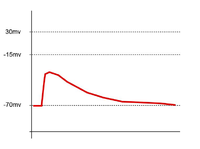Excitatory postsynaptic potential

When our brains think and work, they use tiny cells called neurons. These neurons pass messages and information to other neurons by a process called 'synapse.' This synapse allows the information to travel from one neuron to another. When information reaches the end of a neuron, it is passed on to the next neuron by a small gap called the 'synaptic cleft.'
Now, coming to Excitatory Postsynaptic Potential (EPSP), which is simply a way for neurons to communicate with each other. Imagine you are in a room with your friends, and you need to get their attention to tell them something. You shout, and when they hear you, they respond, and the same goes for neurons. One neuron sends a message to another neuron by sending chemicals through the synaptic cleft.
The chemicals sent across the gap are either inhibitory (that calm the receiving neuron down) or excitatory (makes the receiving neuron 'excited' and charged up). And, when enough excitement is added, the receiving neuron fires off its own message.
EPSP is like a little push that helps the neurons pass along the message. When a neuron receives an EPSP, it becomes 'excited' and is more likely to fire off its own message to the next neuron. It is like giving a little boost to an already excited neuron to pass on the message to its neighboring neurons.
So, to sum it up, when the neurons communicate, they send chemicals across a gap, and when an excitatory chemical is sent, it makes the receiving neuron become excited and more likely to pass on the message to the next neuron. This excitation is called 'Excitatory Postsynaptic Potential.'
Now, coming to Excitatory Postsynaptic Potential (EPSP), which is simply a way for neurons to communicate with each other. Imagine you are in a room with your friends, and you need to get their attention to tell them something. You shout, and when they hear you, they respond, and the same goes for neurons. One neuron sends a message to another neuron by sending chemicals through the synaptic cleft.
The chemicals sent across the gap are either inhibitory (that calm the receiving neuron down) or excitatory (makes the receiving neuron 'excited' and charged up). And, when enough excitement is added, the receiving neuron fires off its own message.
EPSP is like a little push that helps the neurons pass along the message. When a neuron receives an EPSP, it becomes 'excited' and is more likely to fire off its own message to the next neuron. It is like giving a little boost to an already excited neuron to pass on the message to its neighboring neurons.
So, to sum it up, when the neurons communicate, they send chemicals across a gap, and when an excitatory chemical is sent, it makes the receiving neuron become excited and more likely to pass on the message to the next neuron. This excitation is called 'Excitatory Postsynaptic Potential.'
Related topics others have asked about:
